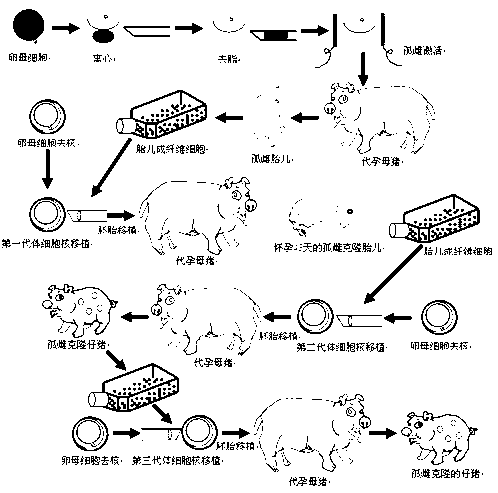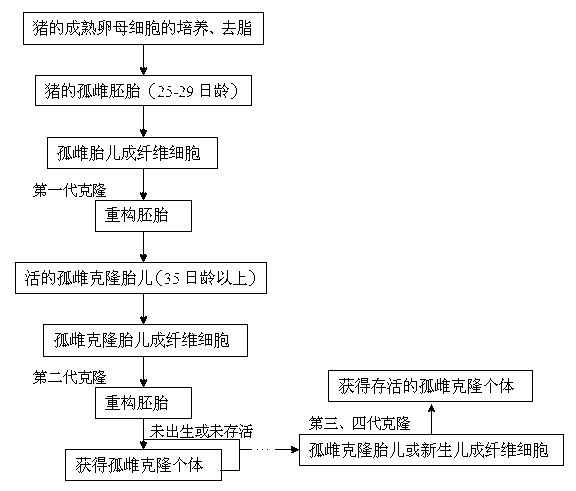Method for producing parthenogenetic cloned pig by means of continuous cloning technology
A parthenogenetic and technical technology, applied in the field of reproductive biology, can solve problems such as inability to spontaneously proceed, and achieve the effects of strong practicability, prolonged development time, and high controllability
- Summary
- Abstract
- Description
- Claims
- Application Information
AI Technical Summary
Problems solved by technology
Method used
Image
Examples
Embodiment 1
[0031] Using somatic cell nuclear transfer technology to continuously clone pig fetal fibroblasts, and finally obtain surviving pig individuals, the specific implementation methods are as follows:
[0032] The first step is to obtain pig parthenogenetic fetal fibroblasts;
[0033] The pig ovaries are collected from the slaughterhouse, stored in normal saline and transported back to the laboratory, where the pig oocytes are picked and matured in vitro. The mature oocytes are centrifuged at high speed (13000rmp, 20min), so that the fat particles are aggregated into clusters and the fat particles are removed by micromanipulation technology. Then parthenogenetic activation is performed on it to obtain parthenogenetic embryos, and the parthenogenetic embryos are transplanted into surrogate sows that are in estrus on the same day to continue to develop.
[0034] On the 23rd day, the sows were diagnosed with pregnancy, and the 25-day-old surrogate sows were subjected to laparotomy t...
Embodiment 2
[0042] Using somatic cell nuclear transfer technology to continuously clone pig fetal fibroblasts, and finally obtain surviving pig individuals, the specific implementation methods are as follows:
[0043] The first step is to obtain pig parthenogenetic fetal fibroblasts;
[0044] The pig ovaries are collected from the slaughterhouse, stored in normal saline and transported back to the laboratory, where the pig oocytes are picked and matured in vitro. The mature oocytes are centrifuged at high speed (13000rmp, 20min), so that the fat particles are aggregated into clusters and the fat particles are removed by micromanipulation technology. Then parthenogenetic activation is performed on it to obtain parthenogenetic embryos, and the parthenogenetic embryos are transplanted into surrogate sows that are in estrus on the same day to continue to develop.
[0045] On the 23rd day, the sows were diagnosed with pregnancy, and the 25-day-old surrogate sows were subjected to laparotomy t...
PUM
 Login to View More
Login to View More Abstract
Description
Claims
Application Information
 Login to View More
Login to View More - R&D
- Intellectual Property
- Life Sciences
- Materials
- Tech Scout
- Unparalleled Data Quality
- Higher Quality Content
- 60% Fewer Hallucinations
Browse by: Latest US Patents, China's latest patents, Technical Efficacy Thesaurus, Application Domain, Technology Topic, Popular Technical Reports.
© 2025 PatSnap. All rights reserved.Legal|Privacy policy|Modern Slavery Act Transparency Statement|Sitemap|About US| Contact US: help@patsnap.com


